


This article highlights the essential treatment options available for patients with hypertrophic cardiomyopathy (HCM), focusing on a compassionate, multidisciplinary approach. It encompasses medications, surgical interventions, lifestyle changes, and ongoing patient education, all aimed at providing comprehensive care. By detailing various treatment strategies, it underscores the importance of early diagnosis and advocates for collaborative care among healthcare professionals. This teamwork is crucial for improving patient outcomes and enhancing quality of life.
Are you or a loved one facing concerns about HCM? It's natural to feel anxious about health issues, but rest assured that there are effective solutions available. Early intervention can make a significant difference, and understanding your options is the first step toward better health. The article encourages a supportive environment where healthcare professionals work together to provide the best possible care, ensuring that patients feel valued and understood.
In addition to this, ongoing education and lifestyle adjustments play a pivotal role in managing HCM. Patients are encouraged to engage in discussions with their healthcare providers, fostering a collaborative relationship that prioritizes their well-being. Remember, you are not alone on this journey. There are resources and support systems in place to help you navigate your health with confidence and clarity.
Take a moment to reflect on your health and the importance of seeking help when needed. Your well-being is paramount, and reaching out for support is a courageous step. Together, we can work towards a healthier future, filled with hope and improved quality of life.
Hypertrophic cardiomyopathy (HCM) presents a complex challenge for patients and healthcare providers alike, often characterized by the abnormal thickening of the heart muscle. Early diagnosis is crucial for effective management, and individuals facing this condition must navigate a landscape filled with various treatment options. This article explores ten essential strategies for managing HCM, from innovative medications to lifestyle changes and surgical interventions.
As the medical community continues to uncover advancements in care, we must ask ourselves: what are the best paths to ensure optimal health and quality of life for those affected by this often-overlooked heart condition? Together, we can find the answers and support one another on this journey.
At Amavita Heart and Vascular Health, we understand how concerning it can be to face a condition like hypertrophic cardiomyopathy treatment, which involves an abnormal thickening of the heart muscle. Under the compassionate guidance of Dr. Pedro Martinez-Clark, who has dedicated his career to enhancing heart medicine, our team is here to support you. We utilize advanced diagnostic tools and customized care strategies designed to achieve the best possible outcomes for each individual.
Dr. Martinez-Clark is known for his empathetic approach, fostering genuine relationships with those he treats. He provides honest and clear information about their conditions, ensuring patients feel informed and valued. His leadership in over 25 clinical research studies, including the innovative Trans-Caval method, means that our patients often have access to the latest therapies even before they become widely available elsewhere.
This commitment to compassionate care and cutting-edge techniques makes Amavita a trusted choice for individuals navigating hypertrophic cardiomyopathy treatment. We are here to help you every step of the way, ensuring you receive the support and understanding you deserve.
Recognizing the symptoms of hypertrophic cardiomyopathy (HCM) early is crucial for effective management. Many individuals may experience:
Research indicates that those diagnosed early can significantly improve their outcomes with hypertrophic cardiomyopathy treatment, as timely intervention helps mitigate the risks associated with this condition. Regular check-ups and screenings are essential, particularly for those with a family history of heart disease, to facilitate early detection of HCM.
At Amavita Heart and Vascular Health®, we understand the importance of thorough cardiac evaluations. Our approach includes advanced risk assessment tools and lifestyle modifications that support early diagnosis and effective management of HCM. Did you know that approximately 85% of individuals with HCM may remain undiagnosed? This statistic highlights the need for increased awareness and proactive health monitoring.
By prioritizing early diagnosis and taking advantage of our hypertrophic cardiomyopathy treatment options, you can access a broader range of therapies. This proactive approach not only enhances your options for hypertrophic cardiomyopathy treatment but also improves your overall quality of life. Remember, we are here to support you every step of the way, ensuring you feel valued and cared for in your health journey.
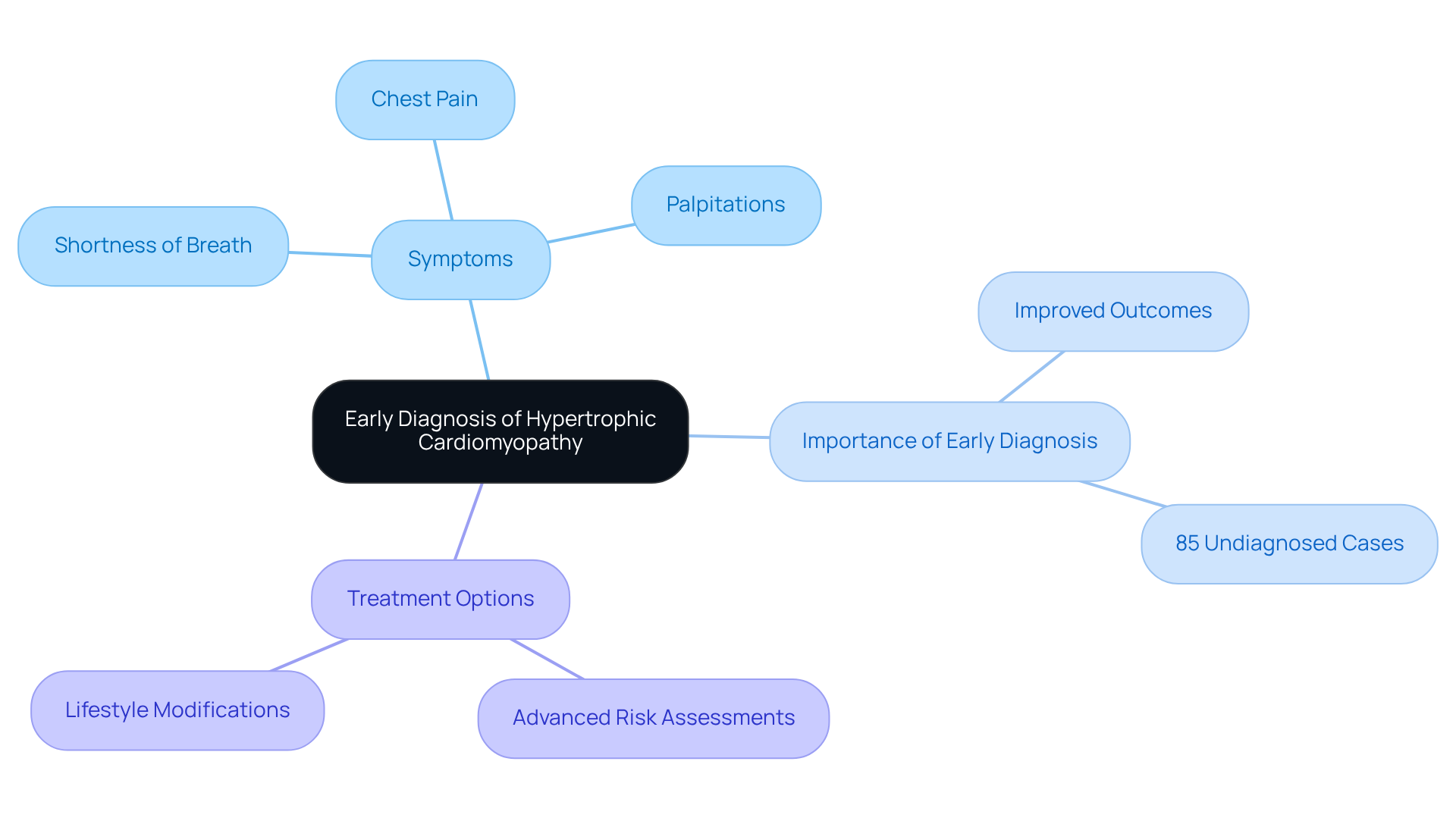
Managing hypertrophic cardiomyopathy treatment can be challenging, but medications such as beta-blockers and calcium channel blockers are here to help. These medications effectively alleviate symptoms like chest pain and shortness of breath, providing relief for those affected. At Amavita Heart and Vascular Health, our specialists recognize the importance of beta-blockers in significantly lowering the risk of hospitalization and overall mortality for individuals with heart failure with preserved ejection fraction (HFpEF), a condition often associated with HCM. In fact, studies reveal that over 75% of individuals with HFpEF are treated with beta-blockers, highlighting their essential role despite ongoing discussions about their efficacy in certain groups.
Calcium channel blockers (CCBs) also serve a vital purpose in the hypertrophic cardiomyopathy treatment. They assist in lowering heart rate and improving blood flow, making them particularly beneficial for those who may not tolerate beta-blockers well. However, it's important to be aware that while CCBs can lower the likelihood of adverse cardiovascular events, individuals treated with them may face heightened risks. This makes CCBs a valuable option for managing hypertension and related heart conditions.
At Amavita, we pride ourselves on working closely with individuals to create personalized medication plans that align with their unique health profiles, especially in the context of hypertrophic cardiomyopathy treatment. Our patient-centered approach not only enhances the effectiveness of hypertrophic cardiomyopathy treatment but also fosters a supportive environment for those navigating the complexities of this condition. Furthermore, we utilize advanced diagnostic imaging and minimally invasive procedures, ensuring that each individual receives comprehensive care tailored to their specific needs. Remember, you are not alone on this journey; we are here to support you every step of the way.
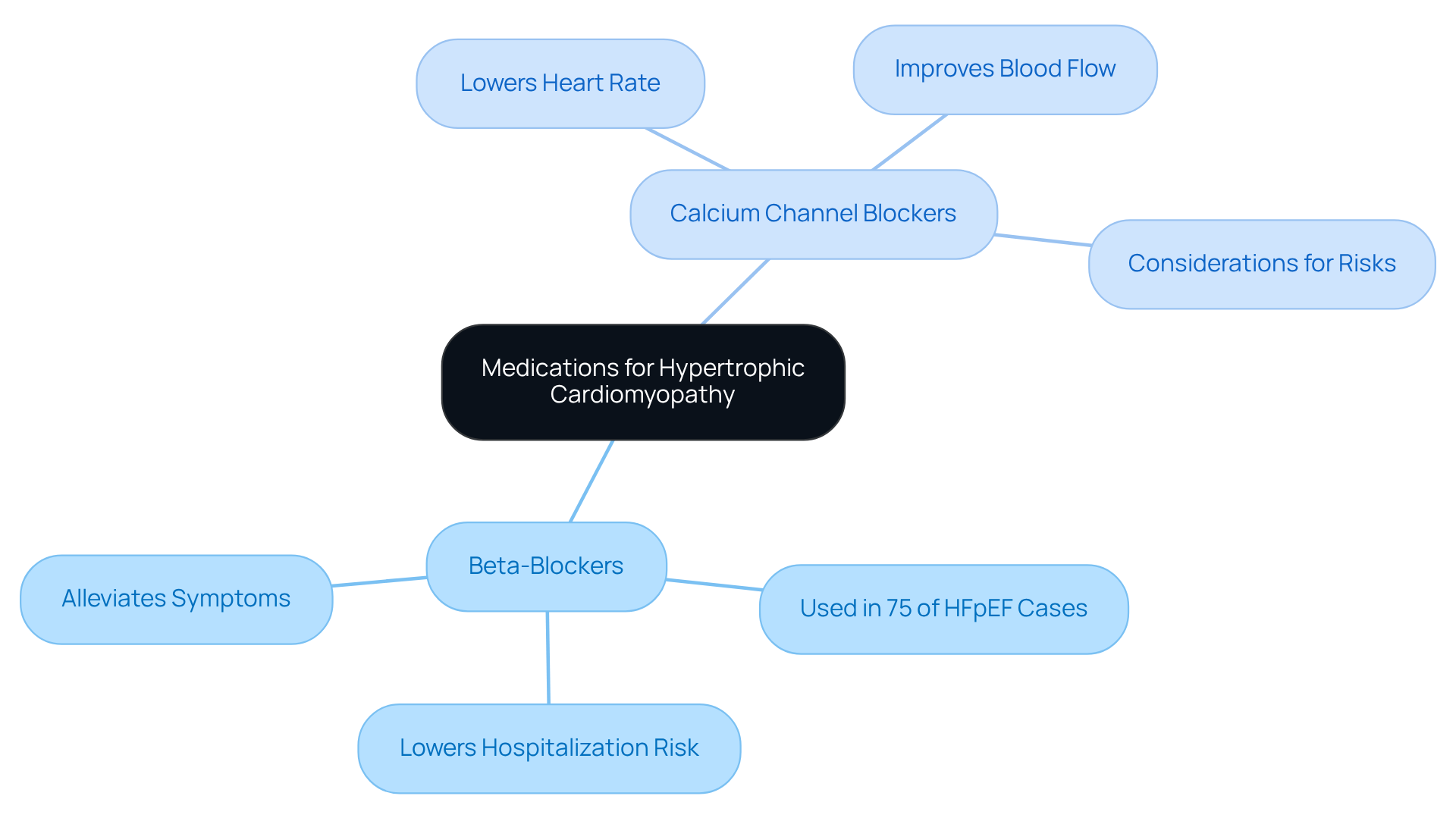
When medications do not sufficiently control the symptoms of hypertrophic cardiomyopathy treatment (HCM), it can be concerning for patients and their loved ones. Surgical interventions, such as septal myectomy and alcohol septal ablation, are valuable options to consider for hypertrophic cardiomyopathy treatment. These procedures are part of hypertrophic cardiomyopathy treatment, aiming to reduce the thickness of the heart muscle, enhance blood flow, and alleviate distressing symptoms. Notably, septal myectomy has shown remarkable outcomes, with survival rates at 1, 5, and 10 years being 98%, 96%, and 83%, respectively, which are comparable to those of the general population. This surgical approach is especially beneficial for individuals experiencing severe drug-refractory symptoms, as hypertrophic cardiomyopathy treatment significantly improves quality of life and reduces the risk of sudden cardiac death.
In contrast, while alcohol septal ablation is less invasive, it has been associated with higher long-term all-cause mortality compared to myectomy, highlighting the importance of careful patient selection. Patients who undergo surgical myectomy often experience significant symptomatic relief and hemodynamic improvement following the operation. The skilled surgical team at our facility is dedicated to these advanced techniques, ensuring that each patient receives personalized care tailored to their unique health needs and circumstances.
By utilizing the latest techniques and insights from leading experts, we are committed to delivering optimal outcomes through hypertrophic cardiomyopathy treatment for individuals facing its challenges. Additionally, through our CardioElite™ program, we enhance cardiac care by integrating advanced diagnostic data and providing 24/7 cardiology consultation. This integration not only facilitates proactive management but also addresses the high cardiovascular readmission rates at skilled nursing facilities, ultimately transforming the approach to cardiac care for our patients. We understand that navigating these health challenges can be daunting, but rest assured, we are here to support you every step of the way.
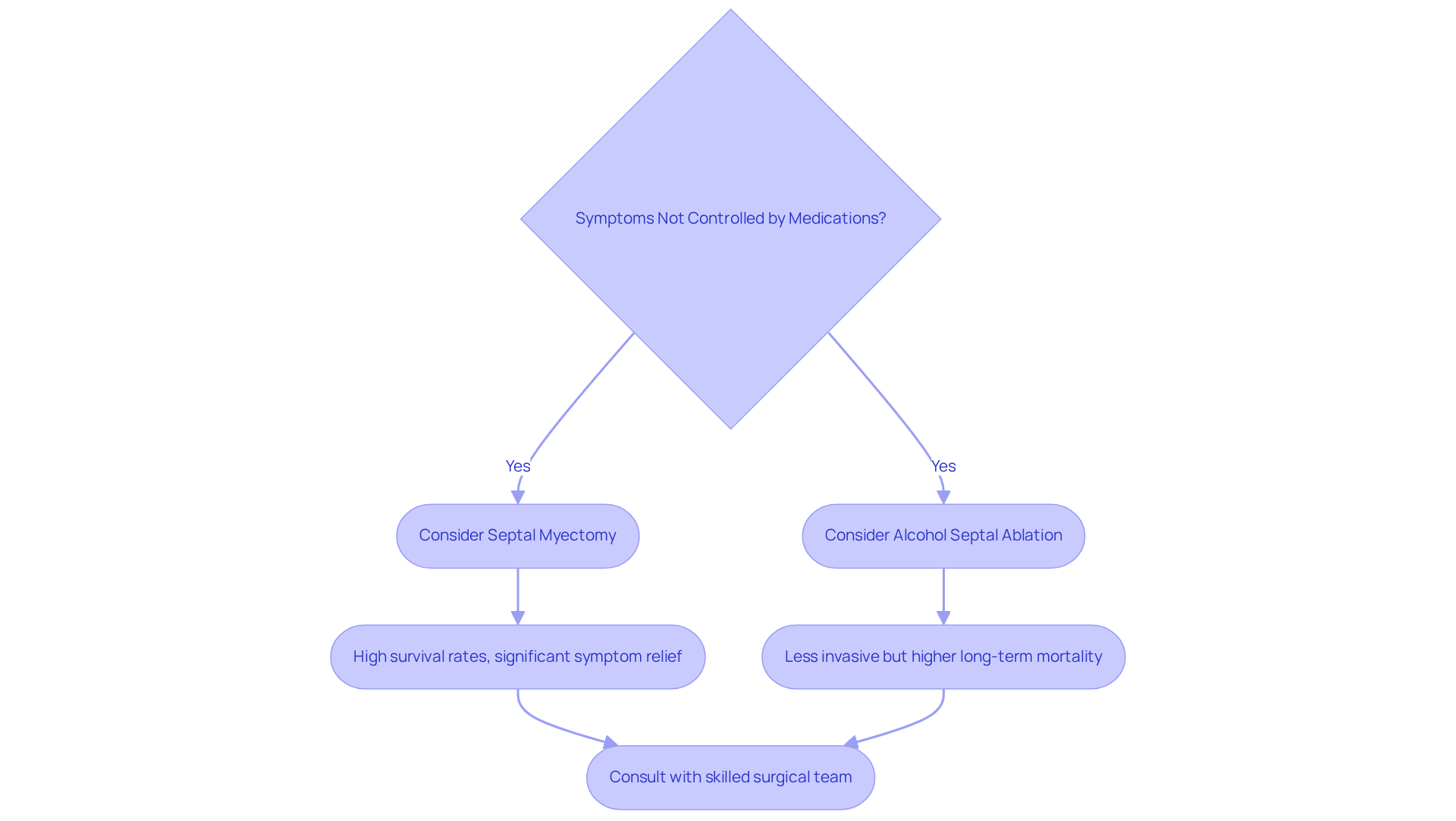
Embracing a heart-healthy lifestyle is essential for effective hypertrophic cardiomyopathy treatment. Have you considered how regular physical activity can make a difference? Engaging in moderate-intensity exercises like walking, yoga, and tai chi can significantly improve heart health and alleviate symptoms. Research shows that such activities help lower heart rate and blood pressure, which is particularly beneficial for individuals with HCM. By focusing on moderate-intensity exercises, you can enhance your cardiovascular function without putting undue strain on your heart.
A balanced diet is another cornerstone in hypertrophic cardiomyopathy treatment. It’s important to prioritize a heart-healthy diet rich in fruits, vegetables, whole grains, and lean proteins while minimizing saturated fats, sodium, and added sugars. Additionally, limiting alcohol consumption and avoiding smoking are crucial steps, as these factors can worsen HCM symptoms. This dietary approach not only promotes overall cardiovascular health but also supports weight management, which is vital, as being overweight can exacerbate the need for hypertrophic cardiomyopathy treatment.
Stress management is equally important. Have you tried techniques such as deep breathing, meditation, or ensuring you get enough sleep? These practices can help reduce stress, which is known to elevate blood pressure and worsen heart conditions. According to NYU Langone heart specialists, "Exercise is essential for health and wellbeing, and we encourage people with HCM to exercise."
Amavita Heart and Vascular Health® offers resources and support to assist individuals in adopting these lifestyle changes, fostering a proactive approach to heart health. By integrating these strategies, you can enhance your quality of life and better manage your condition. Remember, you are not alone on this journey; support is available to help you every step of the way.
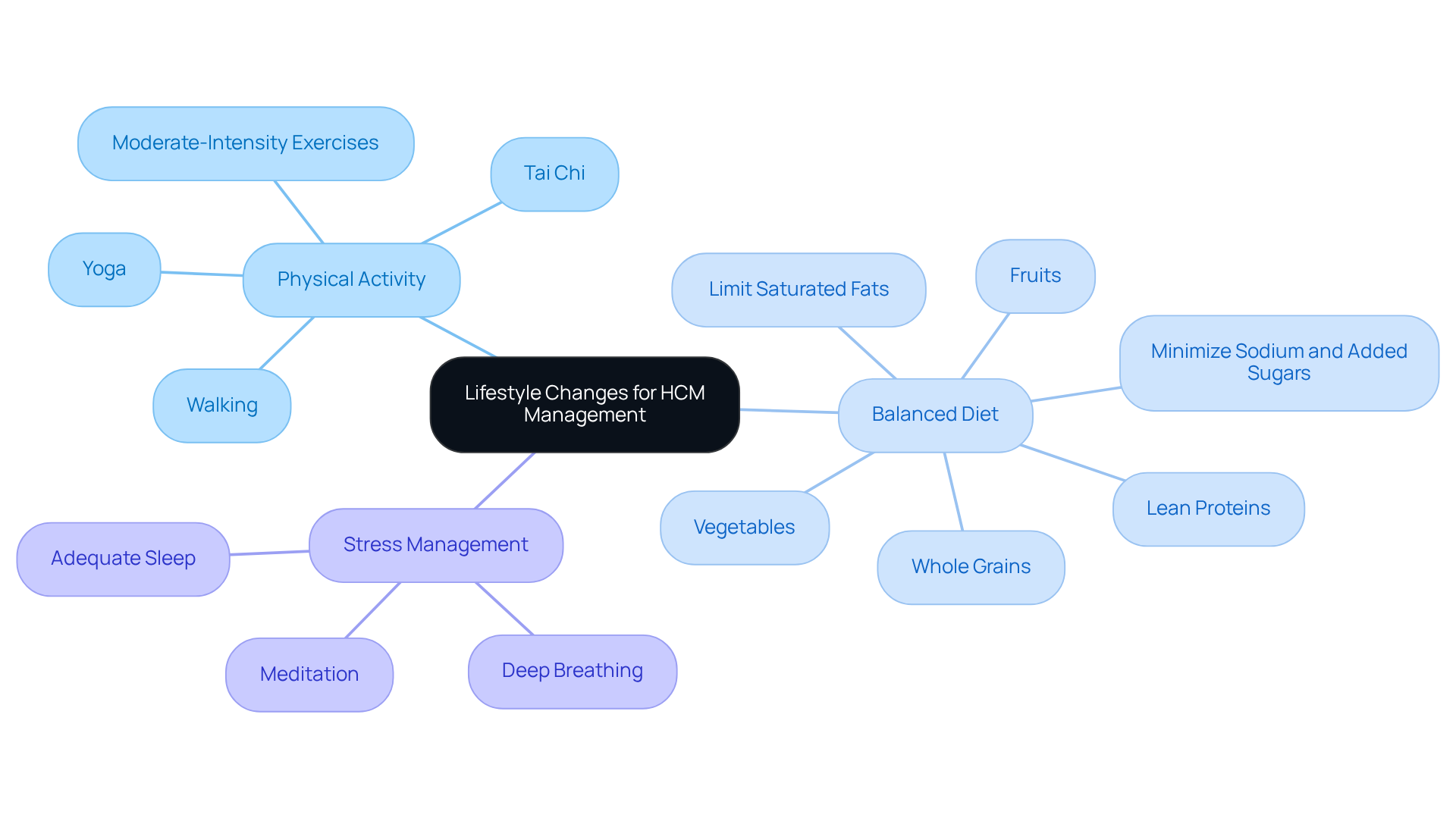
Routine follow-up visits are vital for individuals undergoing hypertrophic cardiomyopathy treatment. These visits not only allow for ongoing observation of disease progression and therapeutic effectiveness but also empower healthcare providers to tailor treatment plans to meet individual needs. Have you ever wondered how consistent care can impact your health? Research shows that regular follow-up can lead to improved health outcomes, with studies indicating that individuals who engage in monitoring experience fewer complications and enjoy a better quality of life. It's heartening to note that mortality rates for those with HCM have improved to around 0.5%, underscoring the importance of continuous care.
The Optimal Program, available for $416/month, offers comprehensive biomarker panels and cardiac screenings, including a cardiac calcium score. This ensures that you receive thorough evaluations and personalized care tailored to your unique situation. Furthermore, the latest 2024 guidelines advocate for routine assessments and recommend regular mild to moderate aerobic exercise for all asymptomatic HCM individuals. This aligns with our commitment to providing optimal care strategies that support your health journey.
Experts emphasize the significance of maintaining a strong, ongoing relationship with healthcare professionals. Such connections not only foster trust but also encourage you to actively participate in your health journey. This active engagement can lead to better compliance with treatment plans and improved overall outcomes for those living with HCM. Remember, you are not alone in this journey; support is always available to help you thrive.

At Amavita, we are deeply committed to enhancing the lives of individuals living with hypertrophic cardiomyopathy (HCM) by offering a wide array of educational resources designed to empower and support. Did you know that HCM affects approximately one in every 500 people? This statistic underscores the vital need for education and support for many individuals and their families.
Our offerings include:
By equipping individuals with knowledge, we play a crucial role in effective management, helping them navigate their condition with confidence and resilience.
Research shows that when individuals are informed, they are better equipped to take an active role in their care, leading to improved health outcomes and a stronger sense of empowerment. It's also important to note that a child of an affected parent has a 50 percent chance of inheriting the genetics that can lead to HCM. This reality highlights the necessity of family education and genetic testing, ensuring that everyone is aware and prepared.
Support groups are essential in this journey, offering a nurturing environment for emotional support and shared learning. These connections can significantly influence the management of HCM, fostering a sense of community that is so important. The Hypertrophic Cardiomyopathy Association (HCMA) stands out as a valuable resource, advocating for education and creating a supportive network that encourages understanding and compassion.
By guiding individuals through their diagnosis and helping them thrive on their journey toward improved heart health, Amavita emphasizes the importance of comprehensive support in managing hypertrophic cardiomyopathy treatment. We invite you to reach out and explore the resources available to you—together, we can make a difference in your health and well-being.

Hypertrophic cardiomyopathy (HCM) poses significant risks, including arrhythmias and heart failure, which can deeply impact individual health. It's essential to recognize warning signs; symptoms like sudden shortness of breath, fainting, or palpitations should prompt immediate medical attention. Research indicates that about 25% of individuals with HCM experience arrhythmias, with atrial fibrillation being the most common. This underscores the importance for individuals to be vigilant about their symptoms and to engage in open discussions with their healthcare team regarding any concerns.
At Amavita, we are committed to providing expert diagnosis and minimally invasive treatment options for conditions such as chest pain and arrhythmias. Our specialists utilize advanced diagnostic imaging to identify potential blockages and arrhythmias, ensuring that individuals receive timely and effective care. For those experiencing chest discomfort, our minimally invasive procedures, including cardiac catheterization and stent placement, can restore blood flow, allowing most individuals to return home the same day with relief from their symptoms.
Furthermore, Amavita offers comprehensive arrhythmia management, employing continuous monitoring technology to accurately identify the specific type of arrhythmia and provide advanced solutions to restore the heart's natural rhythm. This outpatient approach minimizes disruption to individuals' lives while achieving excellent results.
Patient education plays a vital role in managing the risks associated with hypertrophic cardiomyopathy treatment and coronary artery disease. By fostering awareness of potential challenges, individuals can more effectively navigate their care journey. Recent research emphasizes the significance of early intervention and monitoring in hypertrophic cardiomyopathy treatment, as timely recognition of symptoms can lead to improved outcomes. We encourage patients to share their family history and any personal symptoms with their healthcare providers, as this information is crucial for developing effective management plans. A collaborative approach among healthcare professionals is essential to ensure comprehensive care and optimal outcomes in hypertrophic cardiomyopathy treatment.
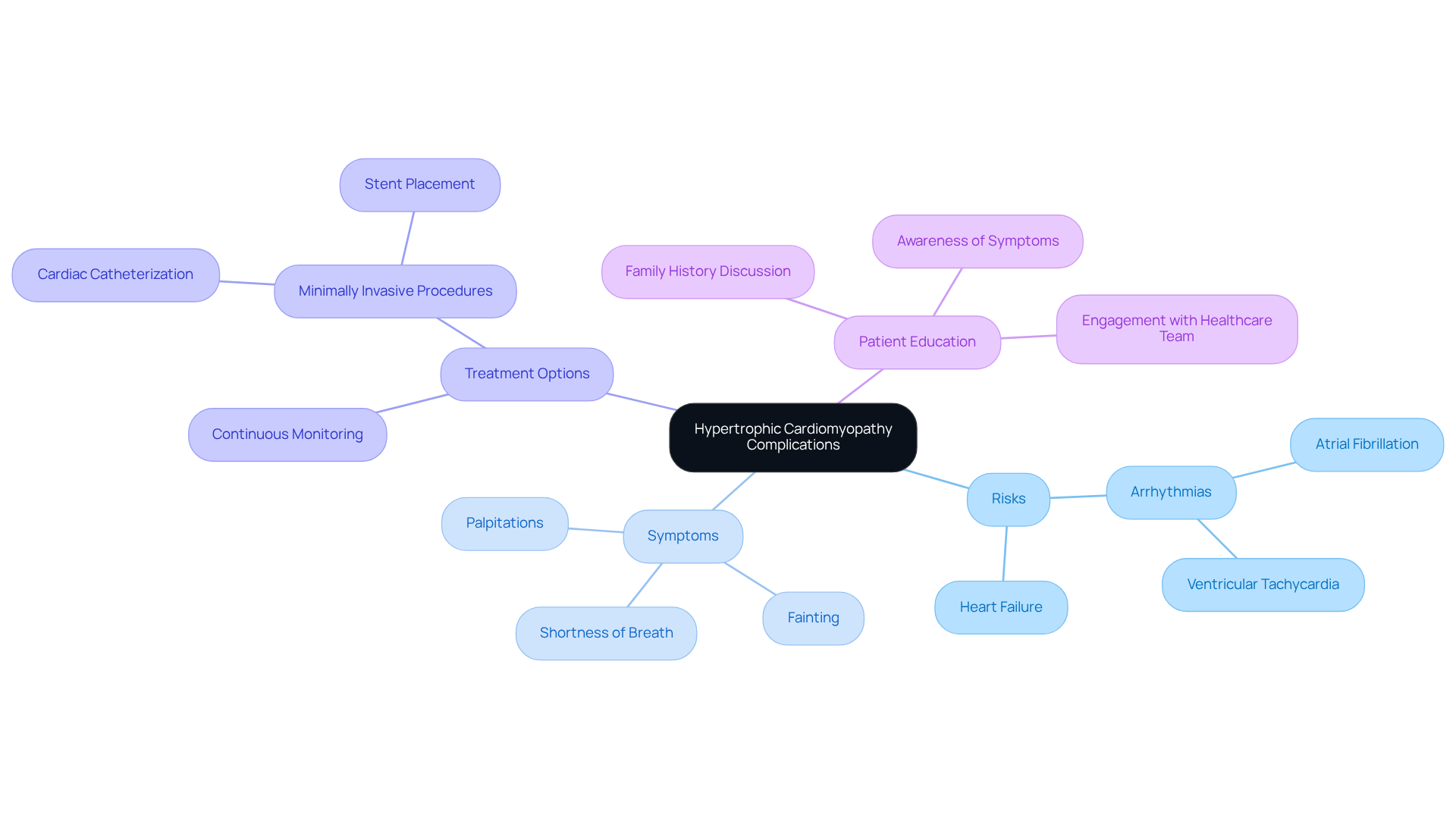
At the forefront of innovative research, our organization is dedicated to enhancing options for hypertrophic cardiomyopathy treatment for those affected by HCM. We understand that navigating health concerns can be daunting, which is why we engage in clinical trials that provide individuals access to groundbreaking therapies not yet widely available. This commitment reflects our deep-seated dedication to advancing cardiovascular health.
Recent studies have shown promising results for new therapies, such as mavacamten and aficamten, which represent advancements in hypertrophic cardiomyopathy treatment by targeting the underlying causes of obstructive HCM. Mavacamten stands out as the first FDA-approved drug specifically for hypertrophic cardiomyopathy treatment, demonstrating significant improvements in symptoms and decreasing the need for invasive procedures. We are excited to share that ongoing trials at esteemed institutions like Oregon Health & Science University are exploring aficamten's efficacy. These trials reveal its potential to enhance oxygen utilization during exercise, ultimately improving daily functioning for patients.
Our dedication to research not only underscores our mission to deliver exceptional care but also positions us as a leader in the evolving landscape of hypertrophic cardiomyopathy treatment options. Furthermore, we are proud to partner with AISAP to deploy AI-powered point-of-care ultrasound technology in underserved communities. This initiative enables faster and more efficient diagnoses for conditions like aortic stenosis and other valvular diseases, ensuring that everyone has access to the care they need.
We invite you to reach out for support and to learn more about how these advancements can positively impact your health journey. Remember, you are not alone—we are here to help you every step of the way.
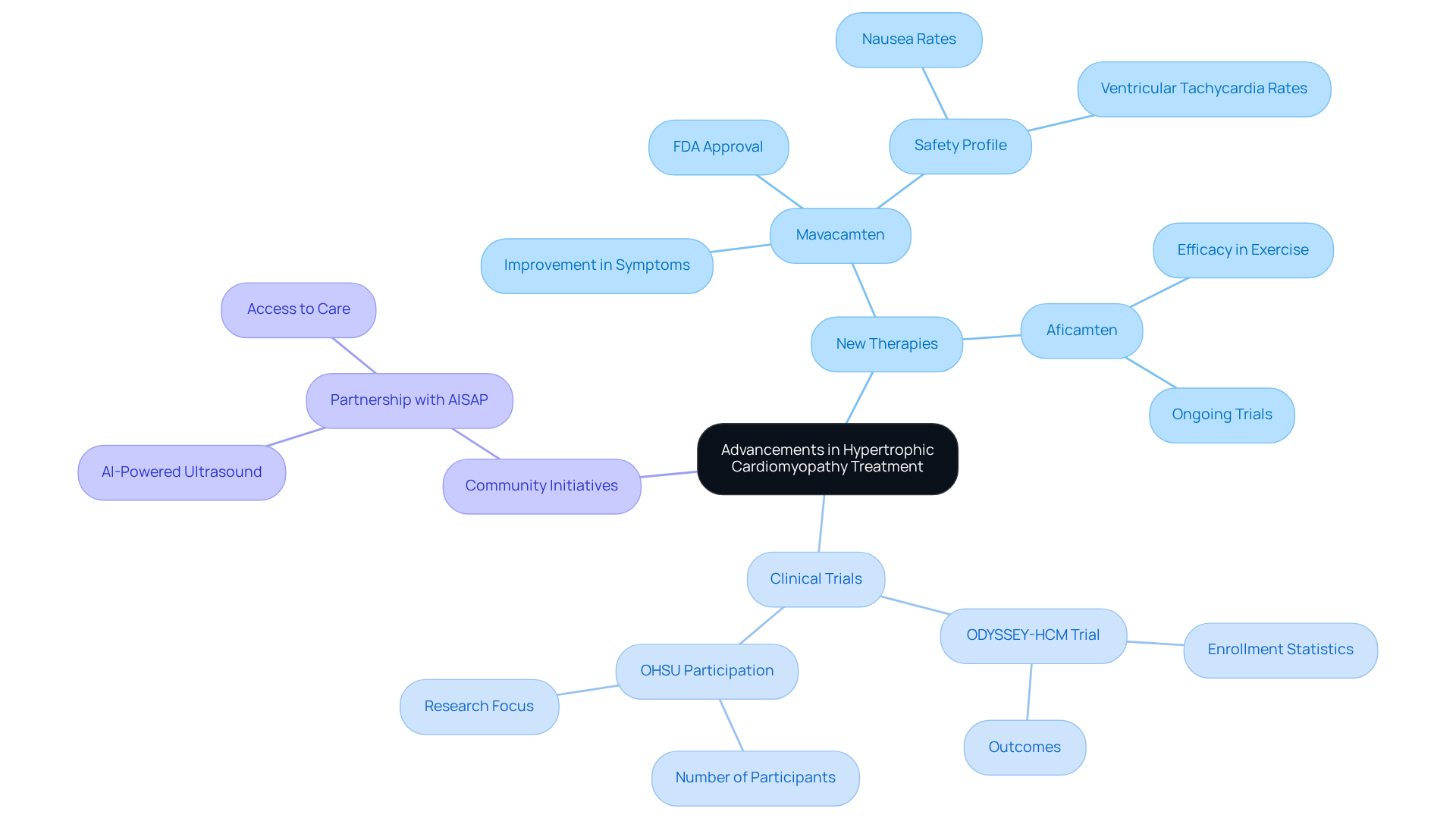
Effective management of hypertrophic cardiomyopathy treatment requires a compassionate and collaborative effort from a diverse team of healthcare professionals, including:
At Heart and Vascular Health®, we embrace this multidisciplinary approach, ensuring that every aspect of your health is thoughtfully addressed. This teamwork is especially beneficial for older individuals who often face various health challenges that require coordinated care.
In addition to this, by integrating specialties such as advanced imaging and genetics counseling, Amavita enhances treatment efficacy and improves outcomes for individuals like you. We foster a holistic environment that prioritizes your well-being. Success stories from elderly patients truly highlight the positive impact of this collaborative model, showcasing how comprehensive care strategies, particularly hypertrophic cardiomyopathy treatment, lead to better management of HCM and an overall improved quality of life. Remember, you are not alone on this journey; we are here to support you every step of the way.
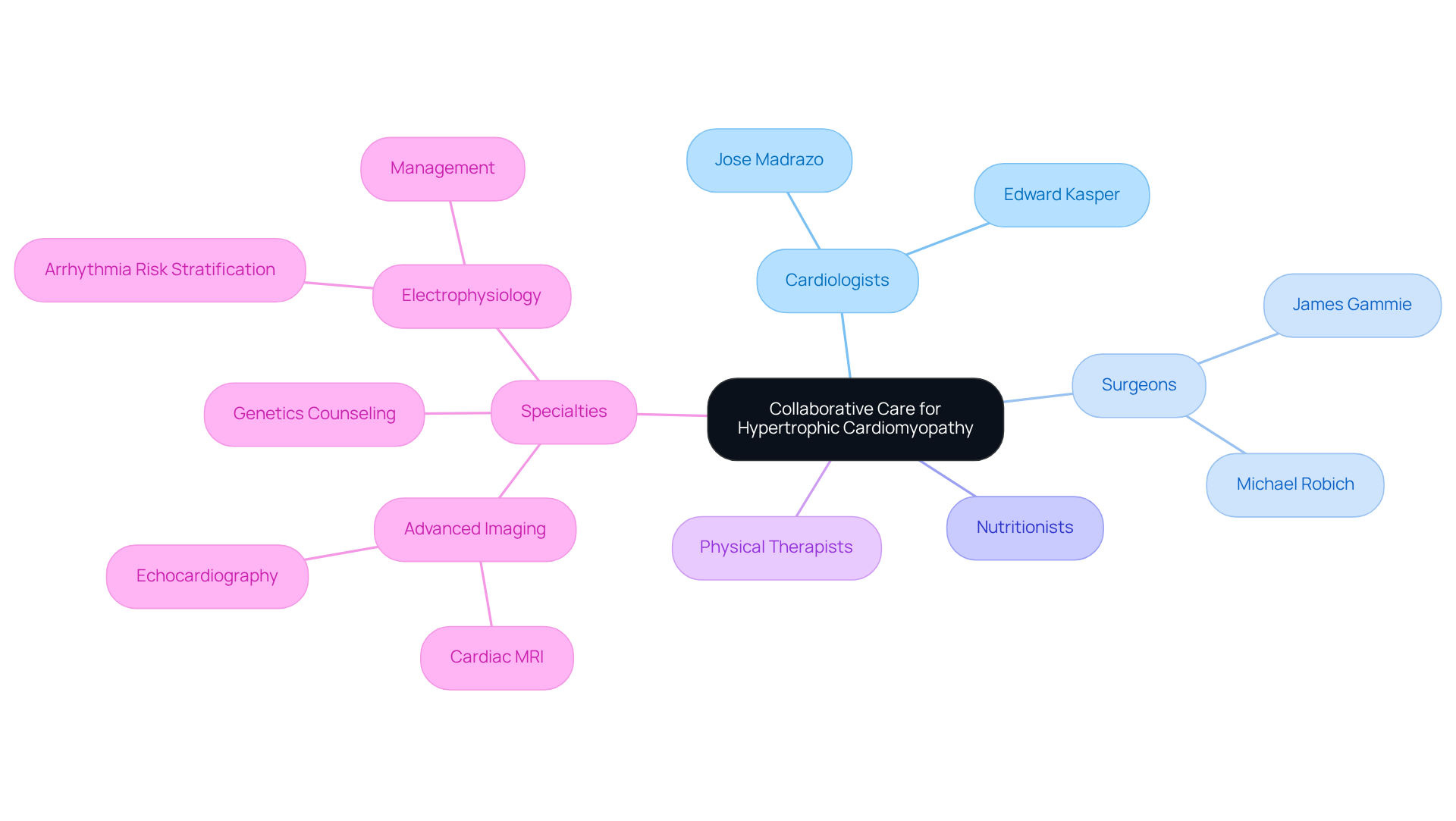
Managing hypertrophic cardiomyopathy (HCM) can feel overwhelming, but it doesn't have to be a solitary journey. It's crucial to recognize symptoms early and engage in proactive management strategies that can significantly improve health outcomes. By working closely with dedicated healthcare professionals and exploring tailored treatment options, individuals with HCM can navigate their condition with greater confidence and a better quality of life.
Early detection is essential. Medications like beta-blockers and calcium channel blockers play a vital role in managing symptoms, and sometimes surgical interventions may be necessary if symptoms persist despite pharmacological management. Embracing lifestyle changes, committing to regular monitoring, and prioritizing patient education are all key elements in comprehensive HCM care. This collaborative approach, involving a multidisciplinary team of specialists, reinforces the importance of support and shared expertise.
In addition to this, ongoing research and innovative therapies are paving the way for new treatment avenues. This ensures that patients have access to the latest advancements in care, which is a source of hope and empowerment.
Ultimately, living with hypertrophic cardiomyopathy can be a journey filled with support and resources. By taking a proactive stance, individuals can empower themselves with knowledge, seek out support, and connect with healthcare providers to create personalized care plans. The resources available, from educational materials to support groups, are invaluable in fostering a sense of community and resilience. Taking these steps not only enhances personal well-being but also contributes to a broader understanding and management of this condition. With the right support and resources, individuals can thrive, even in the face of challenges posed by hypertrophic cardiomyopathy.
What is hypertrophic cardiomyopathy (HCM)?
Hypertrophic cardiomyopathy is a condition characterized by the abnormal thickening of the heart muscle, which can lead to various symptoms and complications.
How does Amavita Heart and Vascular Health support patients with HCM?
Amavita Heart and Vascular Health offers compassionate care under the guidance of Dr. Pedro Martinez-Clark, utilizing advanced diagnostic tools and customized care strategies to achieve optimal outcomes for each patient.
What are the early symptoms of hypertrophic cardiomyopathy?
Early symptoms of HCM can include shortness of breath, chest pain, and palpitations.
Why is early diagnosis important for HCM?
Early diagnosis is crucial as it significantly improves treatment outcomes and helps mitigate risks associated with HCM. Regular check-ups and screenings are essential for early detection, especially for individuals with a family history of heart disease.
What medications are commonly used to treat hypertrophic cardiomyopathy?
Common medications for HCM treatment include beta-blockers and calcium channel blockers (CCBs). Beta-blockers help alleviate symptoms and lower the risk of hospitalization, while CCBs improve blood flow and heart rate.
What role do beta-blockers play in HCM treatment?
Beta-blockers are essential in managing symptoms like chest pain and shortness of breath, and they significantly lower the risk of hospitalization and mortality for individuals with heart failure with preserved ejection fraction (HFpEF), often associated with HCM.
How do calcium channel blockers (CCBs) assist in HCM treatment?
CCBs lower heart rate and improve blood flow, making them beneficial for patients who may not tolerate beta-blockers. However, they may also carry heightened risks for some individuals.
What approach does Amavita take in medication management for HCM?
Amavita focuses on creating personalized medication plans that align with each patient's unique health profile, ensuring comprehensive care tailored to individual needs.
How does Amavita ensure comprehensive care for HCM patients?
Amavita employs advanced diagnostic imaging and minimally invasive procedures, alongside a patient-centered approach, to provide effective and supportive care for those navigating the complexities of HCM.